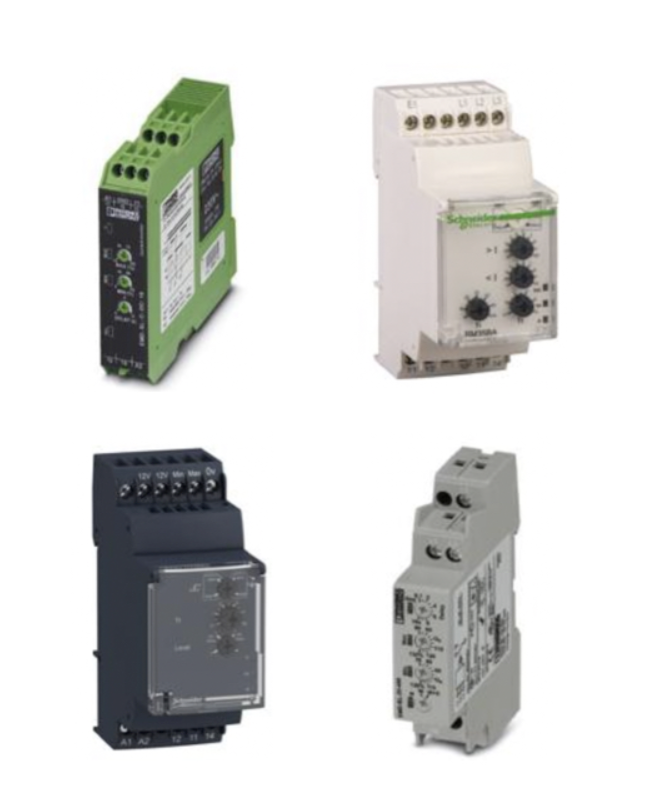Monitoring Relays

Monitoring relays are specialized devices designed to monitor specific electrical parameters, ensuring reliable protection and control of equipment and systems. These relays provide valuable functions such as phase sequence monitoring, voltage monitoring, phase failure detection, current monitoring, and more. They are widely used in various applications and industries to safeguard electrical systems, prevent damage, and minimize downtime.
Voltage monitoring relays are a common type of monitoring relay used to monitor and protect against voltage-related issues. They can detect overvoltage and undervoltage conditions, ensuring that electrical equipment operates within the specified voltage range. These relays provide reliable protection by quickly detecting voltage anomalies and initiating appropriate actions to prevent equipment damage or failure.
Current monitoring relays are another important category of monitoring relays. They continuously measure electrical currents and provide alerts or trigger actions if current levels exceed predefined thresholds. This helps protect equipment from overcurrent conditions, preventing overheating and potential damage. Current monitoring relays are often used in motor control applications to ensure the safe and efficient operation of motors.
More Information about Monitoring Relays
Monitoring relays offer a range of features and functions, such as phase loss detection, asymmetry monitoring, power factor measurement, and temperature monitoring. They can be configured with different settings and parameters to suit specific application requirements. Many monitoring relays provide easy configuration options, allowing users to set thresholds, time delays, and other parameters based on their specific needs.
By employing monitoring relays, users can enhance the safety and reliability of their electrical systems. These relays provide real-time monitoring and alerts, enabling prompt action to be taken in case of any abnormalities or faults. With their ability to detect and prevent potential issues, monitoring relays help protect equipment, reduce downtime, and improve overall system performance.
When selecting monitoring relays, it is important to consider the specific parameters to be monitored, the voltage or current range required, the desired functions and features, and the application's unique needs. Reliable and high-quality monitoring relays are essential for maintaining the integrity and efficiency of electrical systems in various industrial and commercial environments.
FAQs
Does a monitoring relay device monitor phase voltage?
Yes, a monitoring relay device can monitor phase voltage. Phase voltage monitoring is a critical function provided by many monitoring relays to ensure the proper functioning of electrical systems. These relays measure the voltage levels of individual phases in a three-phase system and compare them to predefined thresholds or acceptable ranges.
Top 5 Things You Must Know About Relays
Voltage Matters
Most relays are identified using the voltage the coil is rated for. The contact side of the relay will be rated for an entirely different voltage. It is very common for the contact side of the relay to be rated up to 250V AC (or DC). It is also important to note that AC and DC coils are different, and are NOT interchangeable.
Know the difference between Normally Open (NO) and Normally Closed (NC)
Most relays have either a NO contact or a NC contact. It is most common to use the NO contact on a relay, however most circuits can function using one or the other depending on how it has been set up.
A Relay is Not a Contactor
Although relays and contactors function in much the same way, they are NOT the same. Contactors are generally used in scenarios where large amounts of voltage and current need to be switched, whereas relays don't typically switch more than 15 amps and 120V.
A Little Power Goes a Long Way
Relays switch higher voltage circuits with lower voltage control signals. This allows isolation of more sensitive control equipment from higher voltage circuits. Relays are a cheap and easy way to remotely turn and off these types of circuits.
Relays Can Be Used Both Ways
Although it is most common to see relays being used to switch higher voltage circuits, this is not the only way they can be used. Another use for relays is to monitor the “status” of certain devices, such as a motor. To do this, the relay would be wired so that the coil becomes energized when the motor is running. By doing this, a low voltage control signal is sent back to a PLC to signal that the motor is running.

